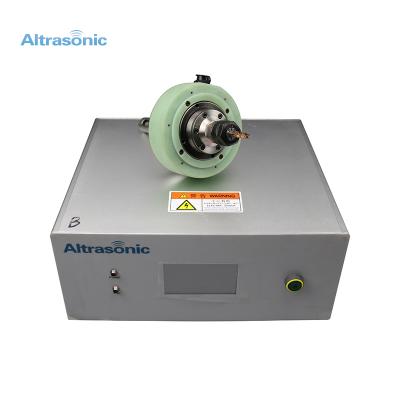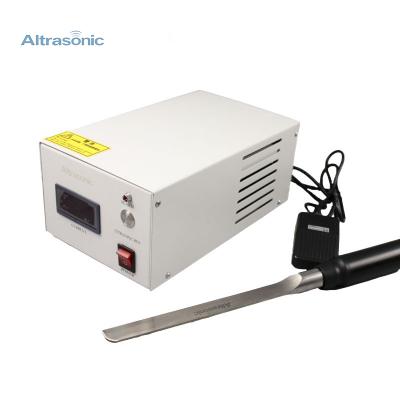Cutting-Edge Precision: The Revolution of Ultrasonic Machining and Advanced Cutting Machines
LEON MACHINERY
3/6/20244 min read


In the realm of precision manufacturing and industrial applications, ultrasonic technology has carved a niche as an innovative and transformative force. From ultrasonic machining to specialized cutting machines, this technology offers unmatched accuracy, efficiency, and versatility across a spectrum of industries. This comprehensive guide delves into the mechanics, applications, and advantages of ultrasonic milling, drilling, and cutting.
Understanding Ultrasonic Machining: The Basics and Beyond
Ultrasonic machining is a non-conventional manufacturing process that uses high-frequency ultrasonic vibrations to remove material from a workpiece. By combining ultrasonic energy with abrasive particles, this technique ensures precision and minimal material deformation.
The Process in Detail
Tool Oscillation: A vibrating tool is connected to a transducer, which converts electrical energy into ultrasonic vibrations.
Abrasive Slurry: A mixture of abrasive particles and a carrier fluid is introduced between the tool and workpiece.
Material Removal: The tool’s vibrations drive the abrasive particles against the workpiece, gradually removing material through micro-chipping.
This process is particularly effective for brittle materials like ceramics, glass, and semiconductors.
Ultrasonic Milling: Redefining Precision
Ultrasonic milling combines traditional milling techniques with ultrasonic vibrations to enhance the cutting process. This hybrid approach is ideal for challenging materials and intricate designs.
Benefits of Ultrasonic Milling
Reduced Cutting Forces: Ultrasonic vibrations decrease the resistance between the tool and workpiece, reducing wear and extending tool life.
Improved Surface Finish: Produces smoother surfaces with minimal defects.
Enhanced Accuracy: Enables precise control over material removal, ensuring consistent results.
Applications
Aerospace Industry: Milling lightweight yet robust materials like titanium and composites.
Medical Devices: Creating intricate designs in biocompatible materials.
Tool Manufacturing: Precision shaping of hard metals and ceramics.
Ultrasonic Drilling: A Game-Changer for Hard Materials
Ultrasonic drilling is designed for materials that are challenging to machine using conventional methods. The process relies on ultrasonic vibrations and abrasive slurry to create holes with exceptional accuracy.
Key Advantages
Minimal Heat Generation: Unlike conventional drilling, ultrasonic techniques generate negligible heat, preventing material distortion.
High Precision: Suitable for micro-drilling applications in sensitive materials.
Versatility: Works effectively on hard, brittle, and non-conductive materials.
Use Cases
Electronics: Drilling micro-holes in circuit boards and semiconductors.
Jewelry: Crafting intricate designs in gemstones.
Engineering: Creating precision components for high-performance systems.
Ultrasonic Cutting Machines: Redefining Efficiency
Ultrasonic cutting machines utilize high-frequency vibrations to slice through materials with unparalleled precision and minimal resistance. These machines are transforming industries ranging from textiles to food processing.
How Ultrasonic Cutting Works
Vibration Mechanism: A blade or horn vibrates at ultrasonic frequencies, creating a high-energy cutting edge.
Localized Heat: Vibrations generate heat at the cutting point, softening the material for easy slicing.
Clean Cuts: The blade moves through the material with minimal friction, producing clean and precise cuts.
Ultrasonic Plastic and Fabric Cutting Machines
Tailored for industrial applications, ultrasonic plastic and fabric cutting machines provide a seamless solution for cutting synthetic and natural materials.
Advantages Over Traditional Cutting
No Fraying: The ultrasonic process seals fabric edges, preventing fraying.
Precision: Cuts intricate shapes with high accuracy.
Efficiency: Operates at high speeds, reducing production time.
Applications
Textile Industry: Cutting synthetic fabrics for apparel and upholstery.
Automotive Sector: Shaping interior materials with precision.
Packaging: Creating clean edges for plastic films and wraps.
Ultrasonic Food Cutting Machines: A Culinary Revolution
The food industry has embraced ultrasonic technology for its ability to produce clean, uniform cuts in a wide range of products. Ultrasonic food cutting machines are especially valued for their efficiency and hygiene.
Key Features
Non-Stick Cutting: Vibrations reduce sticking, making it ideal for sticky or soft foods.
Hygienic Design: Machines are easy to clean, ensuring compliance with food safety standards.
Consistency: Delivers uniform cuts, enhancing presentation and portion control.
Applications in Food Processing
Bakery Products: Cutting cakes, bread, and pastries without deformation.
Confectionery: Slicing chocolates and candies with precision.
Cheese Industry: Creating perfect slices of soft and hard cheeses.
Advantages of Ultrasonic Machining and Cutting Technology
Precision and Accuracy: Ultrasonic vibrations allow for intricate and detailed work.
Material Compatibility: Works effectively on a diverse range of materials, from metals to soft foods.
Eco-Friendly: Consumes less energy and reduces waste compared to traditional methods.
Enhanced Productivity: Speeds up manufacturing processes without compromising quality.
Challenges in Ultrasonic Technology and How to Overcome Them
Initial Cost
The high upfront investment in ultrasonic equipment can be daunting for small-scale operations.
Solution: Focus on long-term cost savings, including reduced maintenance and increased productivity.
Operator Training
Ultrasonic machines require skilled operators to ensure optimal performance.
Solution: Invest in comprehensive training programs and user-friendly machine interfaces.
Material Limitations
Certain materials, like natural fabrics, may not respond well to ultrasonic processes.
Solution: Experiment with material blends or integrate ultrasonic methods with traditional techniques.
Innovations in Ultrasonic Machining and Cutting
The field of ultrasonic technology is continuously evolving, with innovations enhancing its capabilities.
Automation
Fully automated ultrasonic machines are improving efficiency and reducing manual intervention.
AI Integration
Artificial intelligence is enabling smarter machines that adapt to material properties and optimize performance.
Eco-Friendly Solutions
Manufacturers are developing machines with lower energy consumption and recyclable components.
Maintenance Tips for Ultrasonic Machines
Regular Cleaning: Keep the horn, blade, and transducer free of debris.
Alignment Checks: Ensure all components are properly aligned for consistent performance.
Scheduled Inspections: Conduct routine maintenance to identify and address wear and tear.
Use Genuine Parts: Replace components with manufacturer-approved parts to maintain machine integrity.
Choosing the Right Ultrasonic Machine
Selecting the ideal ultrasonic machine depends on your industry needs and materials.
Identify Applications: Determine whether you need machining, milling, drilling, or cutting capabilities.
Material Considerations: Match machine frequency to the materials you work with.
Production Scale: Consider your production volume and choose machines accordingly.
Manufacturer Reputation: Opt for trusted brands that offer reliable support and warranties.
The Future of Ultrasonic Technology
As industries demand greater precision and efficiency, ultrasonic technology will play a pivotal role in shaping the future of manufacturing and processing.
Emerging Trends
Advanced Materials: Expanding applications in cutting-edge materials like composites and nanostructures.
Customization: Machines capable of creating bespoke designs and patterns.
Cross-Industry Applications: Integration into industries like healthcare, automotive, and consumer goods.
Conclusion: Embracing Ultrasonic Innovation
From machining brittle materials to cutting through cakes with precision, ultrasonic technology is redefining the boundaries of what’s possible. Its versatility, efficiency, and eco-friendliness make it a game-changer for industries across the board. As innovation continues, ultrasonic machining and cutting machines are poised to become even more integral to modern manufacturing.
Whether you’re in aerospace, textiles, or food processing, now is the time to embrace the ultrasonic revolution. Invest in this transformative technology to enhance your production capabilities and achieve unparalleled results.


